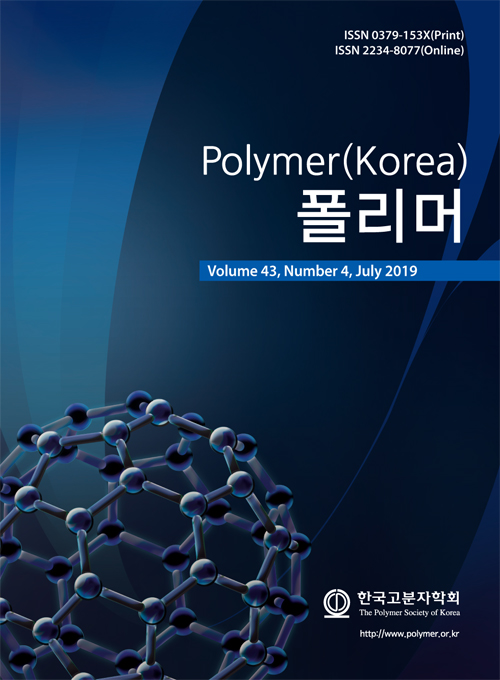- Physical Properties of Flexible Polyurethane Foams Manufactured by Varying Toluene Diisocyanate Contents
Hyeon Jun Choi, Hyeon Choe, Won Jin Seo*, and Jung Hyeun Kim†

Department of Chemical Engineering, University of Seoul, 163 Seoulsiripdae-ro, Dongdaemun-gu, Seoul 02504, Korea
*Interior System Plastic Materials Development Team, Hyundai Motor Group, Hwaseong 18280, Korea- TDI 함량 변화에 따른 연질 폴리우레탄폼의 물리적 특성 연구
서울시립대학교 화학공학과, *현대자동차 내장플라스틱재료개발팀
Polyurethane foams have a wide range of industrial applications. In this study, two types of isocyanates (TDI and MDI) were used in manufacturing the polyurethane foams by varying TDI contents. The cavity diameter of the foams increases with increasing TDI contents, but the cell wall area ratio shows the highest value at 70 wt% TDI content. The cell wall area ratio plays a crucial role in understanding the hysteresis loss and compression stress of the foams. The sag factor and compression set are strongly related to the modulus of the foams depending on the TDI contents. The sag factor decreases but the compression set increases with increasing the TDI contents. These physical properties of the foams are also related to the results of dynamic mechanical analysis under temperature sweep mode.
폴리우레탄폼은 광범위한 산업적 응용분야를 가지고 있다. 본 연구에서는 폴리우레탄폼 제조 시에 사용되는 이소시아네이트를 분자구조가 다른 toluene diisocyanate(TDI)와 methylene diphenyl diisocyanate(MDI)로 선택하고 이들의 함량을 변화시켜 폴리우레탄폼을 제조하고 조성에 따른 물리적 특성에 미치는 영향을 조사하였다. 폴리우레탄폼의 형태학은 TDI 함량이 증가함에 따라 공동크기는 증가함을 보였으며 공동벽 면적비는 70 wt%에서 최고값을 나타냈다. 이러한 형태학적 특성에 따라 공동벽 면적비가 최고값인 조성에서 이력손실과 압축응력이 가장 낮은 결과를 보였다. 또한 TDI 함량이 증가함에 따라 꺼짐인자는 감소하는 경향을 나타냈고 영구압축률은 증가하는 결과를 보였다. 이는 TDI 함량 증가가 폴리우레탄폼의 점탄성 강도를 저하시키게 되고 이로 인해 꺼짐인자 감소와 영구압축률 증가 결과를 가져온 것으로 나타났다. 이러한 폴리우레탄폼의 물리적 특성 변화는 동적 기계적 분석 결과를 통해서도 해석이 가능하였다.
Keywords: polyurethane foam, cell wall, hysteresis loss, sag factor, toluene diisocyanate
- Polymer(Korea) 폴리머
- Frequency : Bimonthly(odd)
ISSN 0379-153X(Print)
ISSN 2234-8077(Online)
Abbr. Polym. Korea - 2024 Impact Factor : 0.6
- Indexed in SCIE
 This Article
This Article
-
2019; 43(4): 532-539
Published online Jul 25, 2019
- 10.7317/pk.2019.43.4.532
- Received on Jan 31, 2019
- Revised on Mar 12, 2019
- Accepted on Mar 20, 2019
 Correspondence to
Correspondence to
- Jung Hyeun Kim
-
Department of Chemical Engineering, University of Seoul, 163 Seoulsiripdae-ro, Dongdaemun-gu, Seoul 02504, Korea
- E-mail: jhkimad@uos.ac.kr








 Copyright(c) The Polymer Society of Korea. All right reserved.
Copyright(c) The Polymer Society of Korea. All right reserved.